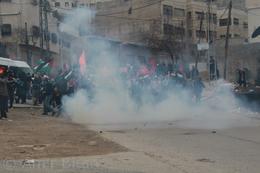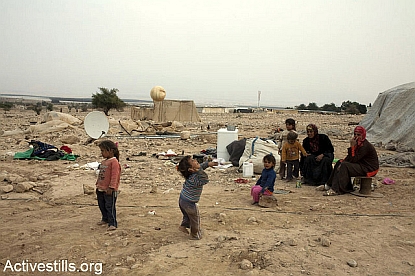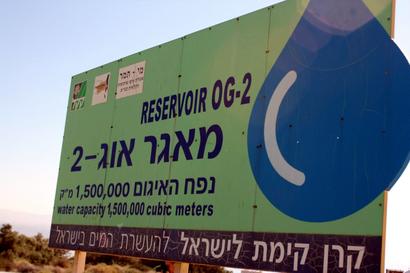
In the Jordan Valley, colonization is based on the exploitation of scarce resources, such as water, for the benefit of the Israeli settlements specializing in export agriculture. For several years the area was cut off from the rest of the West Bank, and currently Palestinian communities holding on to their land are under threat of deportation. The Jewish National Fund is a major actor in the colonization of the Jordan Valley. We are publishing an updated report based on fresh evidence gathered by activists.
The Jordan Valley covers some 30 per cent of the area of the West Bank along it eastern border. The area is inhabited by approximately 65,000 Palestinians (as of 2009). The colonization of the Jordan Valley began already in the late 1960s; now ca. 10,000 settlers live in 37 Israeli settlements whose economic mainstay is agriculture for export. The settlers – who now comprise less than 15% of the area’s population control 860 thousand dunams (86,000 hectares) – that is, almost 50% of the Jordan Valley.1
Water and Exploitation
To understand the true dimensions of the exploitation of natural resources in the dry Jordan Valley by the Israeli agricultural settlements, one needs to look at access to water: The Israeli settlements in the Jordan Valley use one quarter of the annual water consumption of the entire Palestinian population of the West Bank, some 2.5 million people.
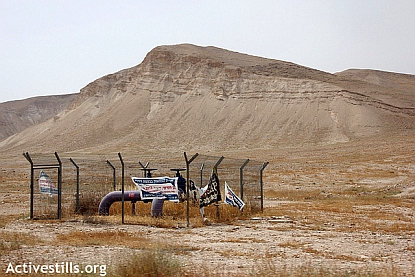
Since 1967, Israel has taken control of most of the water sources in the Jordan Valley, allocating them to the almost exclusive use of settlers in the area. Over-extraction of water by the settlers and the discriminatory allocation of water resources in the northern West Bank have contributed to drinking water shortages and a sharp decline in lands under cultivation for Palestinians. Water shortage affects many parts of the West Bank, but in the dry Jordan Valley, water economy is precarious and vulnerable, and dependent on annual precipitation. Many Palestinian families, mostly Bedouins, have no access to water pipelines and are forced to buy water from tankers, paying on average three times the cost of water for Israeli settlers.
The Jordan Valley's location between the main population clusters of the West Bank and the border with Jordan has made it central in the eye of Israeli military strategists, while its fertile soil and relatively sparse population offers great opportunities to Israeli settlers and settler-entrepreneurs. As they colonize the area, they use the land and its resources, as well as Palestinian labor, now “freed” from its mainly agricultural sources of livelihood. Prime examples for the way Israeli settler-entrepreneurs exploit the people and land of the Jordan Valley are quarries and plantations, run by Israeli corporations and by local Israeli settlements, and based on cheap Palestinian labor.2
According to the Water Authority, settlers in the Jordan valley were allocated 487 liters a day of water per capita; in the northern Dead Sea area – 727 liters; 97.5% of the water is used for agriculture.
In the Jericho district, the area of the West Bank richest in water, per capita daily consumption was 161 liters in 2009. "In villages in the northern Jordan Valley – Bardala and Cardala – per capita daily consumption was 209 liters and in Ein al-Beida, 117 liters. In other areas in the Jordan Valley, the figure was 100 liters less , the minimal water-consumption recommended by the World Health Organization. In the central Jordan Valley, in the area of Wadi al-Far’a, and in the northern Jordan Valley, per capita water consumption was 61 and 61.8 liters. These figures are almost 40 percent lower than the WHO recommendation."3
This is settler-colonial agriculture at its best: Taking the land of the Palestinian inhabitants, robbing them of their water resource, and setting up heavily subsidized water-rich plantations able to make significant profits by taking advantage of the climatic conditions and at the same time, able to completely ignore considerations of sustainability.
Creeping Transfer and House Demolitions
The result, among other things, is what Palestinian activists call "indirect ethnic cleansing": "The difficulty of obtaining water, and its exorbitant price, is prompting many families to leave the Jiftlik area, especially in the summer, in favor of Jericho and other villages. Some families return home in the winter, but others do not." 4
Most of the Jordan Valley is part of area C, that is, it is under Israeli military control and Israeli civil administration. No building permits are issued to Palestinian and hence, all building has become illegal. For the past 15 years the Civil Administration demolished homes in Palestinian villages and town in the Jordan Valley such as Tubas, Beit Furik, Beit Dajan and Tamun. Palestinians report on families forced to leave the area in response to diminishing access to essential resources, isolation and harassment by the military and house demolitions.5
The JNF's Role
According to the JNF website, it “works on security projects throughout Israel”: “Work includes earthworks, drainage, foundations, paving and landscaping.” The Jordan Valley is part of the Palestinian occupied West Bank. Infrastructure for the Israeli settlements has nothing to do with “security”: It is part of the illegal colonization process.
The Jewish National Fund (or KKL, to use its Hebrew acronym) provides the necessary infrastructure for Jewish-only settlement expansion in the Jordan Valley. It fact, the JNF pioneered Israeli projects in the area in the beginning of the 1970s, when Israel’s government was reluctant to admit its colonization projects. In 1972 the JNF constructed the road leading to Gitit settlement, and in 1974, for instance, it prepared 5400 dunams (540 hectares) for 8 settlements.6 Its contribution to the “Allon Road”, a key element of annexation plans, was major (see below). Now the JNF is heavily involved in the expansion of the colonies with a whole series of projects, ranging from infrastructural ones, affecting the water economy of the whole region, to recreation centers for settlers.
Expanding Settlements
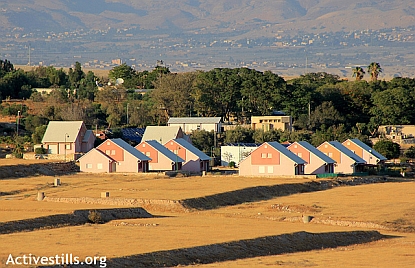
Jordan Solidarity Valley volunteers reported in September 2012 on settlement expansion between the Palestinian Al-Jiftlik village and the Israeli settlement Yafit. The JNF supports the settlement expansion with funding for the contractors providing water, electricity and road infrastructure for the new settlement area.
Water
►The Tirza Reservoir, built by the JNF between 1997 and 2003, collects the flood waters of the largest stream in the West Bank, Wadi al-Far’a before they reach the Jordan River. The water from the reservoir is used by settlements in the area for irrigation of crops and for raising fish.
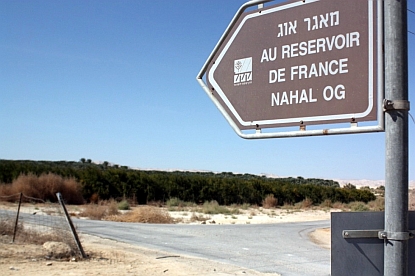
►Now volunteers have documented the OG-2 reservoir with a water capacity of 1,500,000 cubic meters. Around the area they saw sinking holes (soft sand due to low water table).
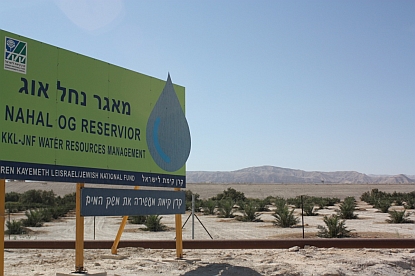
Roads
The role of the JNF in the construction of Allon Road was a major one. The Allon Road connects the Israeli settlements only – there are no branch offs to Palestinian villages from the road. The idea behind Allon Road, began half-secretly in 1972 and completed in 1980, was also to demarcate the area intended for annexation to Israel to the east of Allon Road, leaving the Palestinian main population centers on the mountainous area in the heart of the West Bank isolated.7 A report about the project published by The New York Times caused an international scandal; it was therefore the JNF which was entrusted with making the beginning.
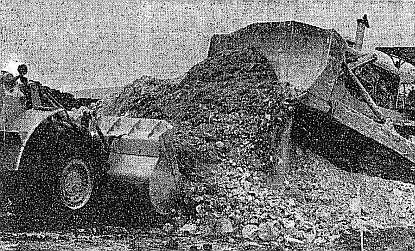
JNF bulldozers preparing the Allon Road, 1973
But the JNF is still paving roads in the Jordan Valley for the settlers:
►JNF donated a dirt road for providing access to land confiscated from Palestinian Bardala
►The JNF builds a major interior street in Mehola settlement
►A farm near Ein El-Beida on Bardala land, paid by the JNF (Mehola farm)
►A road leading to the farm of Mehola settlement, JNF donated
Infrastructure Projects in the Settlements
►All infrastructure at Argaman settlement by the JNF
►Building a celebration hall in Shdemot Mehola
►Building a yeshiva in Shdemot Mehola settlement
►JNF is main donor to the Regional Council of the settlements
Recreation Centers
►Jordan Valley Meeting Point (already documented in Corporate Watch report)
►JNF recreation park Ein Farrah
This is not a conclusive list. The JNF is not publishing reports on its investments and activities available to the general public. The JNF, however, is simply fulfilling its declared mission - colonization. But the question is, can you live with it?
* * *
► The report is based on fresh data collected by volunteers of the Jordan Valley Solidarity Campaign. Warmes thanks - and Support the Campaign!
REFERENCES
[1] Beyond the area controlled by the settlements, closed military zones (mostly claimed by the Israeli army as as “firing” or “training zones” zones) and nature preserves comprise additional 44% of the Jordan Valley, so Palestinian communities have access to less than 10% of the area. Human Rights Watch, Separate but Unequal: Israel’s Discriminatory Treatment of Palestinians in the Occupied Palestinian Territories (2010), p. 65.
[2] B'tselem, Dispossession and Exploitation: Israel’s Policy in the Jordan Valley and Northern Dead Sea (May 2011), pp. 36-39.
[3] B’Tselem, Dispossession and Exploitation, p. 24.
[4] Uri Blau and Yotam Feldman, “Thirsty Land”, Haaretz, 13.8.2009.
[5] Amira Hass, “Otherwise occupied / How green is my valley,” Haaretz, 4.3.2010.
[6] Davar, 22.12.1972; 4.4.1974 [in Hebrew].
[7] See Maariv, 20.2.1973 [in Hebrew].
Further Reading:
- Earlier report on the JNF in the Jordan Valley by CorporateWatch:
- MA’AN Development Center report on the settlements and their main products
- MA’AN Development Center report on the Jordan Valley
- Who Profits report on agricultural exports from the Occupied Territories (May 2012)
- B'tselem Report, Dispossession and Exploitation: Israel’s Policy in the Jordan Valley and Northern Dead Sea (May 2011).
- UN OCHA special report on settlers’ takeover of springs in the West Bank (see references to JNF involvement)
- Oxfam report: On the Brink: Israeli settlements and their impact on Palestinians in the Jordan Valley (July 2012)

